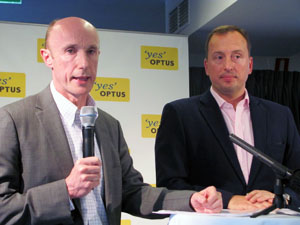Optus jumps on LTE bandwagon

Optus will be launching long-term evolution (LTE) mobile services from April 2012, CEO Paul O'Sullivan today announced after months of speculation.

Optus CEO Paul O'Sullivan and managing director of networks Günther Ottendorfer (Credit: Josh Taylor/ZDNet Australia)
The roll-out of the frequency division duplexing (FDD) LTE network will start in Newcastle, the Hunter Valley and Port Stephens in April 2012, before expanding to Sydney, Melbourne and Perth in mid 2012. As with its major rival Telstra, Optus will utilise existing 1800MHz spectrum that the telco had been using for 2G services to deploy LTE in these areas.
The move into 1800MHz comes in stark contrast to earlier comments from O'Sullivan that Telstra had announced LTE in 1800MHz "for bragging rights". According to O'Sullivan today, he said that the telco had decided to launch early next year, when it believes there will be devices available to utilise it.
"I think what we've announced today is timing, which coincides for when the devices and the ecosystem, the applications and the content will be well developed," he told journalists in North Sydney.
Optus managing director of networks Günther Ottendorfer said that Brisbane, Adelaide, other capital cities and a few regional centres would be the next after Sydney, Melbourne and Perth, but could not confirm dates for these launches.
Optus will also conduct a limited trial of LTE, with network vendor Huawei in the 700MHz spectrum in October at the regional town of Bendigo in Victoria.
The 700MHz spectrum is referred to as the "waterfront" spectrum for mobile broadband services, such as LTE, due to its being able to carry signals for longer distances and provide better building penetration. It is spectrum that is currently used for analog TV broadcasting; however, Bendigo made the switch to digital TV in May this year.
It is expected that the telcos will secure some of the 700Mhz band for LTE networks when the Australian Communication and Media Authority (ACMA) auctions the spectrum in 2012. Ottendorfer said that it is too early for Optus to announce any formal 700MHz LTE roll-out plans.
"We expect in 2014 to 2015 to have it available, and that will influence our roll-out plans. The earlier, the better, for us," he said.
Ottendorfer explained that he expects customers to benefit from the lower latency offered by LTE. At the moment, it is unclear what speeds will be offered for the services with Optus; however, at a trial of LTE last year, Optus reported download speeds of 40 megabits per second between North Sydney and the Sydney central business district.
Optus will launch LTE for both business and consumers at the same time, according to O'Sullivan, who said that it would also make the network available to its wholesale partners, such as Dodo, Internode and iiNet.
"It's a fundamental belief inside the company that we must have a strong wholesale business in order to compete and survive. So we won't be delaying in sharing this network with our wholesale partners," he said. "It's a question of timing for them in terms of system and platforms and ability to deliver."
O'Sullivan would not disclose pricing for the services this morning, but said that the company had historically "been the ones who bring a new price paradigm" to the industry, and he expected this to continue with Optus' LTE products.
The LTE announcement also coincided with the announcement that the carrier would expand of the reach of HSPA+ on its network, and the telco would also use its 900MHZ spectrum, which it had traditionally reserved for 2G, for 3G services.
O'Sullivan said that the latter should lead to greater building penetration for Optus customers using 3G. He said that Optus was able to re-farm this spectrum, because most customers had migrated from 2G services to 3G services.
"What is allowing us to redeploy this spectrum. so that we can get broader distribution of our 3G signal and, indeed, get into more buildings, is the fact that we have sufficient customers who have now migrated to 3G and then freed up the spectrum for that use," he said.
In addition to this, Optus has plans to introduce 500 more mobile sites into its network, and upgrade the infrastructure of around 2500 of its existing sites. The telco also announced that HSPA+ services will be made available at over 700 sites across Australia.
O'Sullivan said he believed that thanks to the $2 billion in upgrades to its network and backhaul over the past four years, as well as doubling its spectrum holdings for 3G in the capital cities, the telco would be able to cope with the extra demand.
"Over 80 per cent of our sites in metro are now connected to fibre and that has been deliberately done to carry more capacity," he said. "Clearly, as we bring on more data traffic and content on the network, it will require more capacity, but by having fibre at the sites, the beauty of fibre is that we can expand the capacity pretty easily and readily."